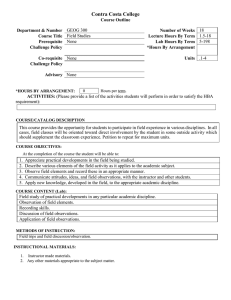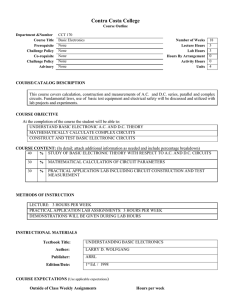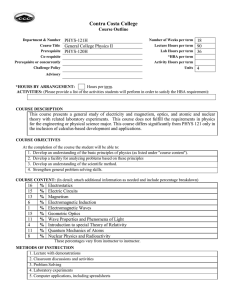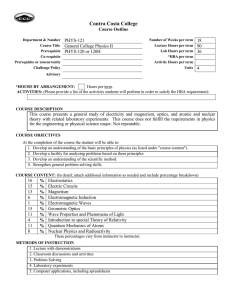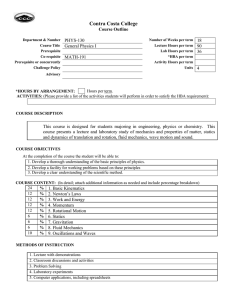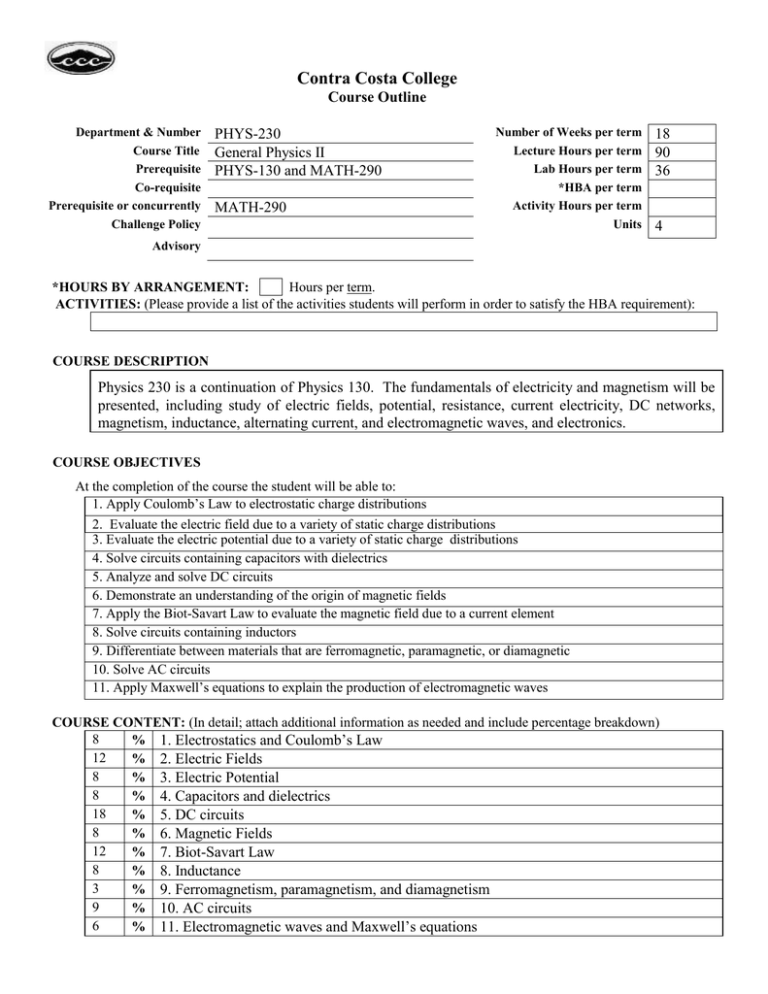
Contra Costa College
Course Outline
Department & Number
Course Title
Prerequisite
Co-requisite
Prerequisite or concurrently
Challenge Policy
PHYS-230
General Physics II
PHYS-130 and MATH-290
MATH-290
Number of Weeks per term
Lecture Hours per term
Lab Hours per term
*HBA per term
Activity Hours per term
Units
18
90
36
4
Advisory
Hours per term.
*HOURS BY ARRANGEMENT:
ACTIVITIES: (Please provide a list of the activities students will perform in order to satisfy the HBA requirement):
COURSE DESCRIPTION
Physics 230 is a continuation of Physics 130. The fundamentals of electricity and magnetism will be
presented, including study of electric fields, potential, resistance, current electricity, DC networks,
magnetism, inductance, alternating current, and electromagnetic waves, and electronics.
COURSE OBJECTIVES
At the completion of the course the student will be able to:
1. Apply Coulomb’s Law to electrostatic charge distributions
2. Evaluate the electric field due to a variety of static charge distributions
3. Evaluate the electric potential due to a variety of static charge distributions
4. Solve circuits containing capacitors with dielectrics
5. Analyze and solve DC circuits
6. Demonstrate an understanding of the origin of magnetic fields
7. Apply the Biot-Savart Law to evaluate the magnetic field due to a current element
8. Solve circuits containing inductors
9. Differentiate between materials that are ferromagnetic, paramagnetic, or diamagnetic
10. Solve AC circuits
11. Apply Maxwell’s equations to explain the production of electromagnetic waves
COURSE CONTENT: (In detail; attach additional information as needed and include percentage breakdown)
8
% 1. Electrostatics and Coulomb’s Law
12
% 2. Electric Fields
8
% 3. Electric Potential
8
% 4. Capacitors and dielectrics
18
% 5. DC circuits
8
% 6. Magnetic Fields
12
% 7. Biot-Savart Law
8
% 8. Inductance
3
% 9. Ferromagnetism, paramagnetism, and diamagnetism
9
% 10. AC circuits
6
% 11. Electromagnetic waves and Maxwell’s equations
METHODS OF INSTRUCTION
1. Lecture with demonstrations
2. Classroom discussions and activities
3. Problem Solving
4. Laboratory experiments using electronic equipment
5. Computer applications, including spreadsheets and computer-based digital sampling oscilloscopes
INSTRUCTIONAL MATERIALS
Textbook Title:
Author:
Publisher:
Edition/Date:
Physics for Scientists and Engineers: A Strategic Approach
Randall D. Knight
Pearson Addison-Wesley
2nd Edition / Copyright 2008
NOTE: To be UC transferable, the text must be dated within the last 5 years OR a statement of justification for a text beyond the last 5
years must be included.
COURSE EXPECTATIONS (Use applicable expectations)
The average reading level of the textbook is 13.1
Homework assignments average nine hours per week.
Laboratory reports average three hours per week.
Outside of Class Weekly Assignments
Weekly Reading Assignments
Weekly Writing Assignments
Weekly Math Problems
Lab or Software Application Assignments
Other Performance Assignments
Hours per week
3
NA
6
3
STUDENT EVALUATION: (Show percentage breakdown for evaluation instruments)
45
15
15
25
%
%
%
%
Exams
Homework
Laboratory Reports
Comprehensive Final Exam
The percentages vary from instructor to instructor.
GRADING POLICY (Choose LG, CR/NC, or SC)
X Letter Grade
90% - 100% = A
80% - 89% = B
60% - 79% = C
50% - 59% = D
Below 50% = F
These percentages vary instructor
to instructor.
Pass / No Pass
Student Choice
70% and above = Pass
Below 70% = No Pass
90% - 100% = A
80% - 89% = B
70% - 79% = C
60% - 69% = D
Below 60% = F
70% and above = Pass
Below 70% = No Pass
Prepared by:
Jon Celesia
Date:
Spring 2012
Form Revised 10/09


